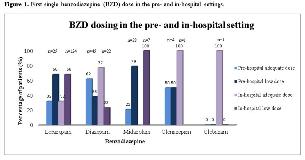Benzodiazepine Dosing in Pediatric Refractory Convulsive Status Epilepticus (the pSERG Cohort)
Abstract number :
1.231
Submission category :
4. Clinical Epilepsy / 4C. Clinical Treatments
Year :
2018
Submission ID :
500540
Source :
www.aesnet.org
Presentation date :
12/1/2018 6:00:00 PM
Published date :
Nov 5, 2018, 18:00 PM
Authors :
Alejandra Vasquez, Boston Children’s Hospital, Harvard Medical School; Marina Gaínza-Lein, Boston Children’s Hospital, Harvard Medical School; Iván Sánchez Fernández, Boston Children’s Hospital, Harvard Medical School
Rationale: Current clinical practice shows variability in first-line benzodiazepine (BZD) dosing during the treatment of status epilepticus (SE). We evaluated the BZD dosing in a cohort of children with refractory SE (RSE), and identified factors associated with variations in dosing. Methods: We conducted a multi-center prospective observational cohort study of pediatric patients (1 month to 21 years) with convulsive RSE, who were admitted from June 2011-December 2017. RSE was defined as the failure of SE termination after at least two antiepileptic drugs, or the use of continuous infusion. We included patients who received a BZD as the first-line medication, and analyzed the first single BZD dose and total BZD dose within the first 10 minutes of treatment initiation. Total BZD dose was calculated by considering the percentage of the minimum recommended dose, for each BZD type, and by adding all BZD dose percentages given within 10 minutes. The total BZD dose was considered low if 100% of the minimum recommended dose was not administered. We used logistic regression modeling to evaluate the relationship between clinically relevant variables and low total BZD dose administration. Multivariate Cox regression analysis was used to assess the relationship between low total BZD dose and time to event secondary outcomes (seizure duration, intensive care unit (ICU) stay). Results: Two hundred fifty-seven patients (54.9% males) were included in the study, with a median (p25-p75) age of 4.3 (1.3-9.9) years. Lorazepam was the most commonly administered BZD (149 patients, 57.9%), followed by diazepam (67 patients, 26.1%), midazolam (35 patients, 13.6%), clonazepam (5 patients, 1.9%) and clobazam (1 patient, 0.4%). One hundred fifty-four patients (60%) received a low first single BZD dose. These included lorazepam 101/149 (67.8%), diazepam 22/67 (32.8%), midazolam 29/35 (82.9%) and clonazepam 2/5 (40%). Lower first single BZD doses occurred in the pre-hospital (58/102; 56.9%) and in-hospital (96/155; 61.9%) settings (Figure 1). One-hundred fifty-four patients (60%) received a low first single BZD dose: lorazepam 101/149 (67.8%), diazepam 22/67 (32.8%), midazolam 29/35 (82.9%) and clonazepam 2/5 (40%).One hundred four patients (40.5%, 68 males) received a low total BZD dose. Male sex (OR 2.2; 95%CI 1.28-3.79; p=0.004) and older age (OR 1.1; 95%CI 1.04-1.16; p<0.001) were independent risk factors for low total BZD dose (Table 1). Additionally, low total BZD dose increased the likelihood of prolonged seizure duration (HR=0.7, 95%CI 0.55-0.92) and prolonged ICU stay (HR=0.8, 95% CI 0.59-0.99). Conclusions: First-single BZD doses were commonly lower than recommended for RSE in both the pre- and in-hospital settings. Males and older children were more likely to receive a lower total BZD dose. Low total BZD dose was associated with longer ICU stays and seizure duration compared with the group treated with minimum recommended BZD dosing (Funded by the Pediatric Epilepsy Research Foundation & Epilepsy Research Fund). Funding: Pediatric Epilepsy Research Foundation and Epilepsy Research Fund

.tmb-.jpg?Culture=en&sfvrsn=709e0b50_0)